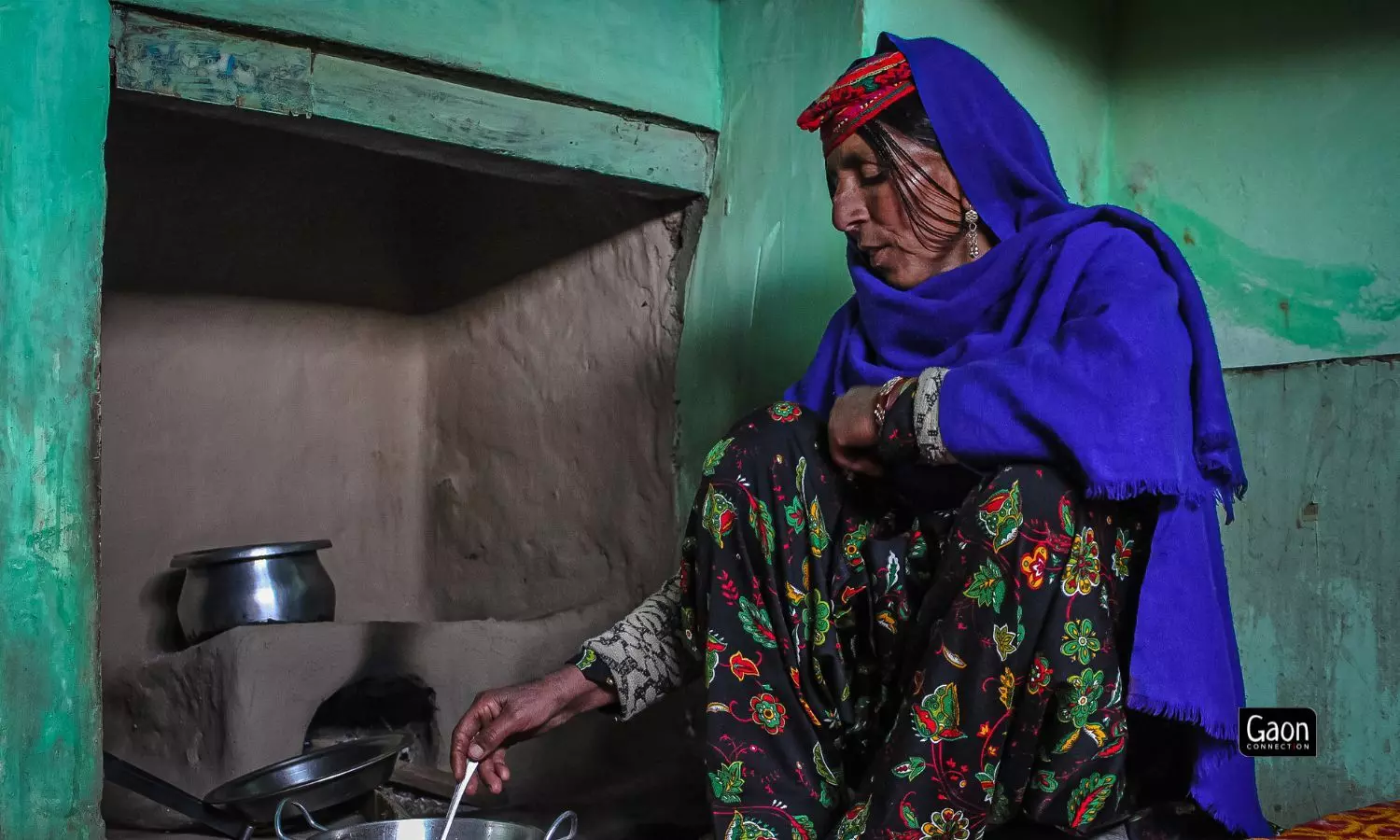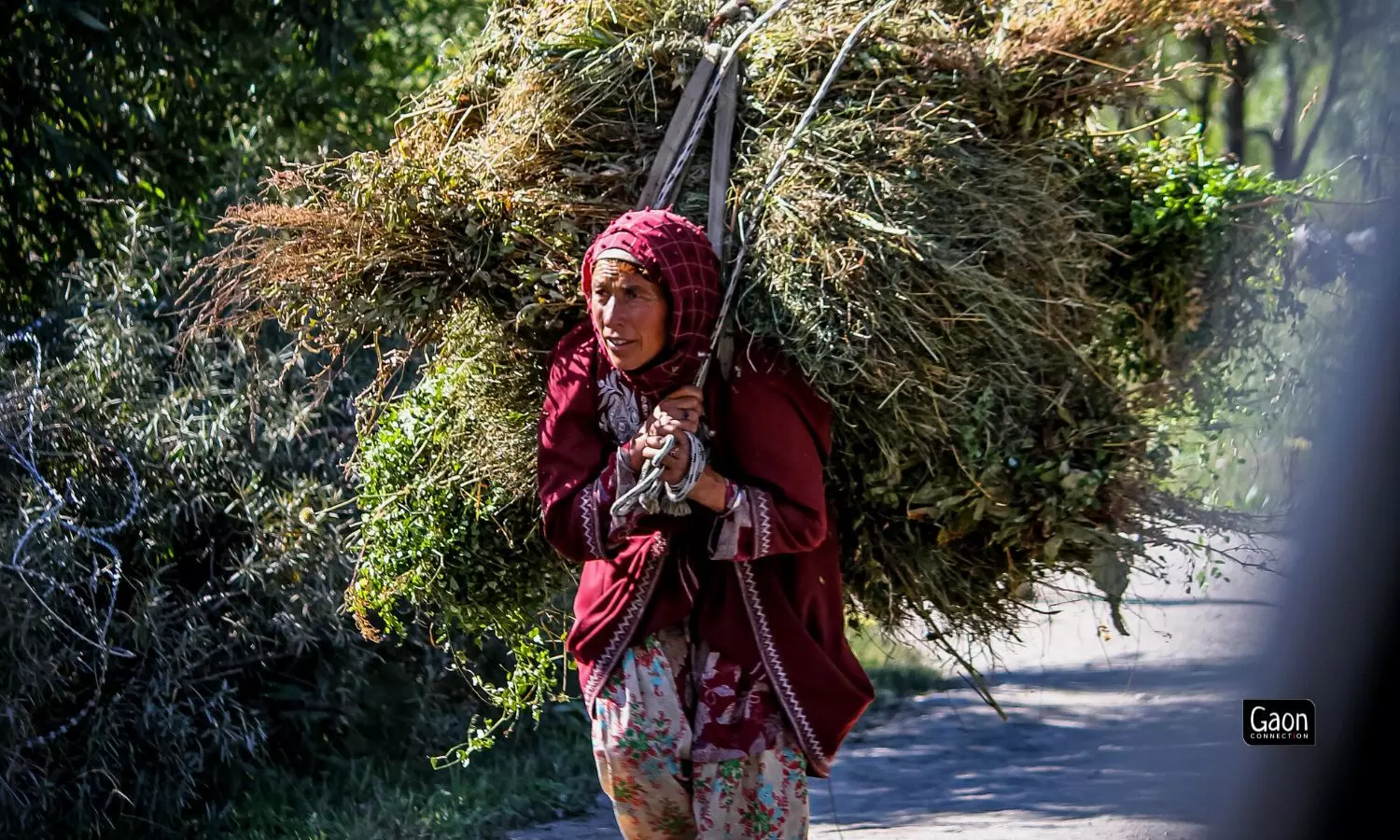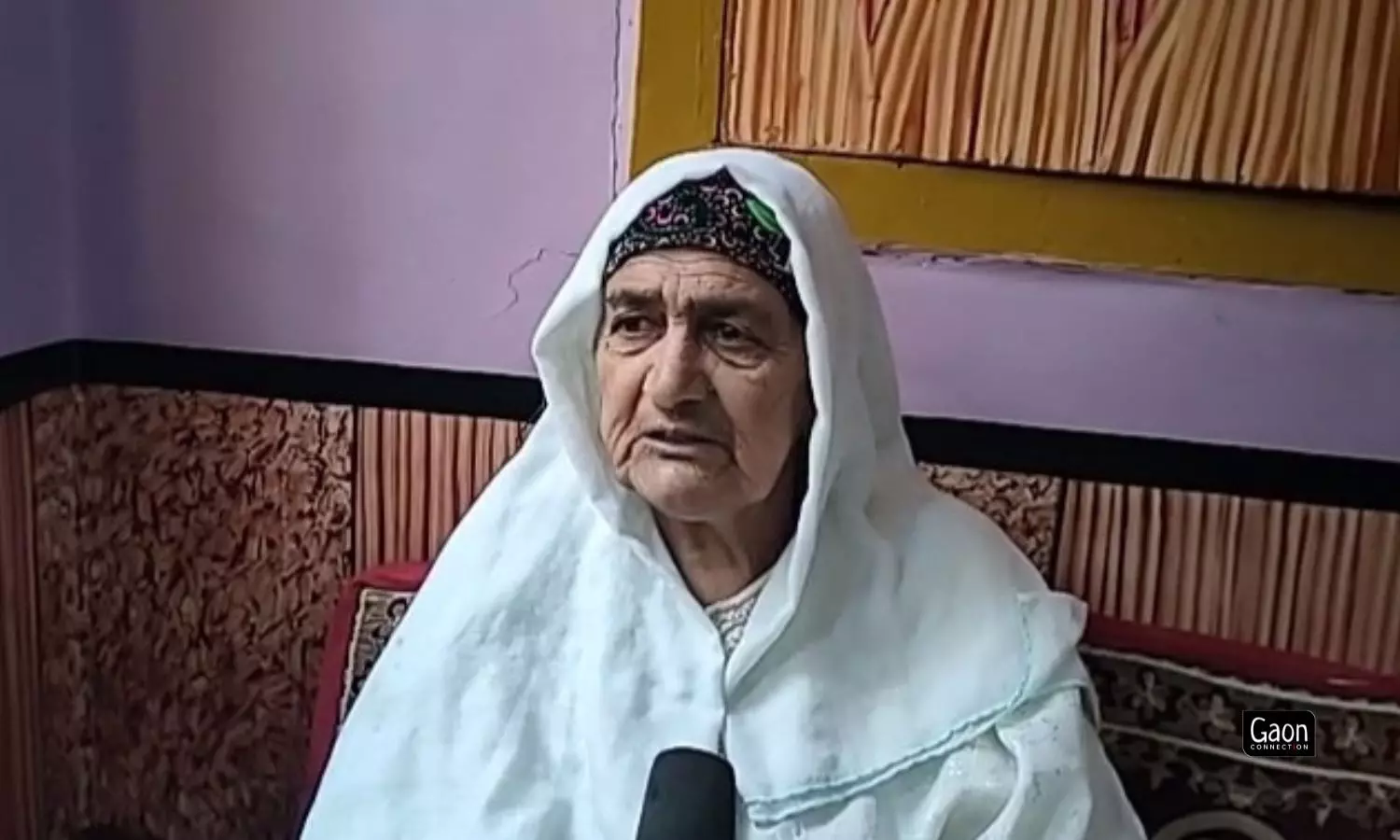Bandipora, J&K
For 28-year-old Nasreena Begum from Chandaji village in Bandipora, Zoona Begum is nothing less than an angel from God. “According to the hospital I visited for my regular check ups, my due date was August 7. The doctors had advised a caesarean delivery. But on August 2, my labour pains began and it was Zoona who helped deliver my son. I had a normal delivery,” a grateful Nasreena told Gaon Connection. Her baby, now almost two months old, is growing up healthy, she said.
Zoona Begum, the 78-year-old dai (traditional midwife) from Ketson village in Bandipora, travels with the rest of her Gujjar community as they migrate to the upper reaches of Kashmir in search of greener pastures for their livestock along with their hearth and home. Their nomadic lifestyle makes it difficult for them to have access to quality healthcare, and it is worse for women who are expecting.

Zoona Begum, a 78-year-old Dai who has been hand holding the women at the time of birth through the entire process.
“The people of my community are constantly on the move. I have often delivered babies out in the green pastures,” Zoona told Gaon Connection. “If I can save someone’s life, nothing is more rewarding than that for me. I will help my people till my last breath,” she said.
Four of Altaf Khan’s children and two of his grandsons were delivered by Zoona dai. “She is always available to us. When the women fall sick or are close to giving birth to the child, we call Zoona and other neighbouring women for help,” 49-year-old Khan from Ketson village told Gaon Connection.
Like in other parts of India, Kashmir Valley in Jammu and Kashmir also has a long tradition of dais who would help deliver babies at home. But, these traditional midwives have been left out of the healthcare system as the focus has shifted towards institutional deliveries, which has helped address maternal and infant mortality.
Also Read: Should India’s health infrastructure embrace traditional midwives?
Two or three generations ago, women gave birth at home with dais like Zoona hand holding them through the entire process. Doctors and nurses didn’t exist, or were available at faraway hospital. People relied on the dais, whose only equipment was their skilled hands, a blade, and mustard oil.
Traditional midwives are still active in the far flung villages of Kashmir, where several villages in the Valley get cut off during the winter season when the region receives heavy snowfall. Many of these midwives may be old and wizened but their years of experience delivering babies have made them a lifeline.

Sundri lives in Ashtangoo on the northern banks of Wular Lake in Bandipora, about 90 kilometres away from Srinagar. She could not remember how old she was when she started midwifery, but said that she was certain that she was helping deliver babies for at least 50 years if not more.
Taja Begum, who is 83 years old, clearly remembers that she learnt to deliver babies from her mother who was a midwife in Langate village in Kupwara district.
“I no longer deliver babies as women in my village and those nearby opt for caesarean deliveries to minimise labour pain,” said Taja. But, in her heyday, the traditional midwife said she assisted many deliveries and it was the money she received for her service that kept her family going.
“I would get about five hundred rupees for successful normal deliveries. I also travelled to adjacent villages that were far from health facilities and helped pregnant women deliver their babies,” narrated Taja.
But there are midwives like Zoona Begum who do not charge money for deliveries. “I usually do not charge money to deliver babies but people do offer me a few hundred rupees or something in kind that I cannot refuse. I am just grateful I can be of help and God will reward me in heaven for this work,” she smiled.
As healthcare services have improved in the region, a number of midwives are out of work. It is feared that the use of traditional skills, acquired through generations of wisdom, and the power of communication in helping younger women have successful deliveries might be lost with these midwives who are in the evening of their life.
The importance of midwives is documented in The State of the World’s Midwifery 2021, a joint report by UNFPA, WHO (World Health Organization), International Confederation of Midwives (ICM) and partners. As per the report, the world is facing a shortage of 900,000 midwives. And, if midwifery was supported, recognised and prioritised it could avert 4.3 million maternal and newborn deaths by 2035.
A younger midwife, Khatija Begum from Dobun village of Bandipora, is proud of helping women deliver babies at home. “I am no professional gynaecologist but with my experience of 15 years, I have helped many young women give birth. I have also learnt a lot more about safe deliveries from the local ASHA worker,” she told Gaon Connection.
Khatija is happy that healthcare facilities have vastly improved in the Valley. “I have been a midwife for 15 years now and it was not too many years ago when women had to walk nearly eight kilometres from their village to the main road to hire a vehicle to reach a hospital,” 59-year-old midwife told Gaon Connection.

Khatija, a tribal Dai on her way to home carrying fodder.
“But now, both awareness about health and improved facilities and accessibility has expectant mothers preferring to go to hospitals for their deliveries,” she added.
Shameema Begum, a gynaecologist posted at the health sub centre in Ketson village, Bandipora, said that between January and August this year, there have been 21 successful deliveries assisted by traditional midwives.
“Several women who have given birth with the help of their midwives come to the sub centre, and they and their babies are doing well,” the gynaecologist said.
But not all midwives have happy stories to share. There have been times the outcomes have not been good because of complications.
For Sundri Begum, who is an incredible 107 years old, there have been so many unforgettable instances that have marked her life as a midwife. But, she said perhaps the midnight knock on her door in 1990 is the one she remembers the most, with some sadness.

Sundri, a 107-yr-old dai could not remember how old she was when she started midwifery, but said that she was certain that she was helping deliver babies.
“There was a curfew and my neighbour was at the door, begging me to help his daughter who was writhing in labour pain,” she said. The case rapidly became complicated and Begum asked her neighbour to shift his daughter to the hospital. “But the area was cordoned off and the baby could not be saved. And, the girl did not have any more babies after that,” Sundri Begum told Gaon Connection.
“I remember thinking that if I had proper equipment or even some kind of training to deal with complicated pregnancies, I may have saved the baby. Ever since, even if there was the barest hint of complication, I immediately recommended moving the mother to the hospital without trying to deliver the baby myself and delaying matters,” she added.
Also Read: “If she wasn’t there that day, my baby would have died”
Like many other midwives, Sundri Begum has had no formal training from a hospital or a medical college, but circumstances had made her a midwife, she said. “My experience over the years has enabled me to handle pregnancy related issues with confidence. I have also learned to administer intravenous injections to expectant mothers,” she said.
Looking back over the years, Sundri Begum said the threshold of pain in the women when she herself was young was much more. “These days women are advised to take bedrest months before their babies arrive,” she said. In days gone by, the women were active and worked almost till the last day. “They worked at their farms, winnowed grains and so on,” the traditional midwife recalled.
According to Mushtaq Ahmad, Medical Superintendent, District Hospital, Bandipora, giving birth through normal delivery decreases the chances of infection for both mother and child. “The women in rural areas have a higher threshold of pain when compared to their urban counterparts which is why there are more normal deliveries in the rural areas,” he said.


















